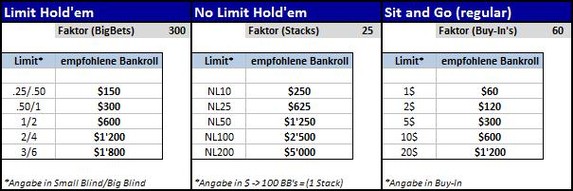Sit N Go Tournaments are currently how I’m tackling my Poker Bankroll Building Challenge. They encompass all aspects of poker: 6max, full ring, deep & short stacks, bubble play, in the money play and heads up play. My poker playing career started off with Sit N Go (SNG) tourneys, and they continue to be my favorite form of poker.
By playing small stakes sit and gos, if you can manage to take down a couple of these, you can start quickly building your bankroll up $5, $10, $20 or even $50 at a time. This will allow you to quickly build a $500 poker bankroll. Since poker tournament by their very nature are extremely high variance (you will go through long periods with any kind of significant score), you need a much more conservative poker bankroll management strategy. So I recommend using a 100 buyin poker bankroll if you play tournaments. And if you are talking about large fields of say 1k or more.
How to Use Bankroll as Part of Your Poker Strategy. Correct bankroll management revolves around having enough buy-ins in our bankroll to help us absorb any likely downswings caused by variance (or occasional bad play). Seeing as the variance we encounter in cash-games, MTTs, and sit-n-goes is different, our approach to bankroll management in. For example with a $110 bankroll you could play 20 x $5+50c Sit and Go’s. A steady rate of return will mean you can move up to the $10+1 Sit and Go’s when your bankroll hits $220 and then the $20+2 level at $440. Most decent Spin & Go players don't exceed 4-5% ROI and only the very best exceed 6%. Related Reading: Poker & Variance: How Good Poker Players Outrun Luck; What Bankroll Do You Need? Should you want play Spin & Gos professionally you want to reduce your risk of ruin as much as possible. Thus you'll need to play with a rather big bankroll.
1) They Develop Well-Rounded Poker Players
Because they encompass so many aspects of poker (full-ring and short-handed, big stacked to short stacked play), SNG players are forced to study how play changes as situations change. They are capable in the early rounds of handling a big 75bb+ sized stack, and deftly handling 10bb stacks on the bubble. SNG players learn to adapt quickly to short handed play and know how to adjust their ranges as fewer players are dealt into the game.
2) Moving-up the Limits is Simple
Starting at the micros and moving up is simple, but not exactly easy. Like anything in life, it takes plenty of time and purposeful practice to become skilled. But once you really understand early game play, ICM implications, targeting FISH, push/fold strategy, bubble play and in the money play, you’ll begin crushing the competition at the lower stakes and you’ll find your bankroll shooting up, and the stakes you play rising with it.
3) Multi-tabling Helps to Up Your ROI
You need to play as many tables as you can while keeping a high level of focus. “Volume = da Monies” in SNG’s, so you need to be as efficient as you can with the time you play. You’ll make more money by effectively playing 8+ tables vs 4, as long as you’re still making the good A-game decisions you’re capable of. More tables also helps to keep variance at bay.
Did you know some of the best SNG players play 24 tables at once? WHAT?!? Add tables one at a time and truthfully assess your play after each session. Did that extra table throw your game off? Did you time out on too many hands? What areas of your game can you improve to allow for quicker decisions and more tables played?
4) SNG Structure Allows for Structured Early Game Play
In general, with SNG’s the old motto of “tight is right” is still completely valid. With the set structure of SNG’s, they allow you to follow a set range of opening and 3betting hands in the early game, which makes it more likely that you’ll get to bubble play most of the time. Having set ranges also allows for more multi-tabling. Don’t let having set ranges make you feel like you’re playing robitically: this is actually sensible and effective poker playing. It allows you to more frequently get to the later stages where your weaker opponents are prone to making tons of mistakes.
5) You Continually Face Many of the Same (Weak) Opponents ?

You’ll find plenty of weak players to exploit across all levels of SNG’s. Your focus is on extracting value from these players. Learn their tendencies and how to exploit them, and watch your ROI shoot through the roof. Time spent studying how to exploit the weak players will be more productive and rewarding than studying how other regs are playing.
6) Your Edge Over the Fish Grows as Blinds Increase

As the tourney progresses and the blind increase, your edge over the fish increases as well. They can often fold away their stack, or start shoving with too wide of a range. Your adjustments to the changing stages of SNG’s will lead to chipping up over your opponents and more wins.
7) Heads Up SNG’s Turns You Into an Exploiting Beast ?
Some of the best players in the world are heads up specialists, not just cash but HU SNG’s as well. These force you to adapt your game to one specific opponent: to find his weaknesses and employ strategies that will dominate him. Purposeful Practice here will allow you to take down 6max and full-ring SNG’s more often, as well as help you take down MTT trophies. And if you ever want to play against the best in the world (think Ike Haxton), heads up experience is absolutely crucial.
8) HUD’s are Essential
Using a poker tracking software like PokerTracker 4 is essential for great SNG play. You’ll encounter lots of the same players and your HUD stats will accumulate quickly, allowing for great reads and exploitative play on your part. Plus, the software will allow you to really dive into your hand histories and study every on the bubble situation and ICM affected hands, helping you to become more adept at these critical junctures.

9) Lots of Formats to Choose From
Most poker sites out there offer straight SNG’s, reg/turbo/hyper speeds, KO tourneys, Double-or-Nothing, PLO and multi-table SNG’s. The variety is so great that even the most bored poker player can find something that can quickly peak their interest, and fact that it’s a contest as opposed to a never ending cash game helps to stimulate interest as well.
10) There’s SOOOOO Much Strategy Content Available
From killer strategy books (like Moshman’s Sit ‘n Go Strategy) to whole websites dedicated to SNG strategy, there’s a plethora of strategy content to dive into. You’ll never be left in the lurch with nothing to study when you’re a SNG Player.
Gestion Bankroll Poker Sit And Goes
If you haven’t gotten into Sit N Go tourneys yet, I highly recommend them to build your bankroll and to improve your poker skills.

Gestion Bankroll Poker Sit And Go Games
This is the first in a series of SNG strategy posts. The next post is on SNG Early Stage Strategy. Check it out.
Until next time, study hard and make your next session the best one yet!
- The 12 Days of Christmas 2020 Podcast Episodes - December 14, 2020
- Strategies and Action Steps from the Quick Wins Poker Course - November 24, 2020
- How to Quickly Understand Online Tournament Players – Podcast #318 - November 18, 2020
When to Move Up Levels and Managing Your Sit and Go Bankroll
Bankroll management for Sit and Go’s is largely dependant on what kind of player you are. There is a large difference between the bankroll requirements for an online professional and that of the recreational player who enjoys playing for fun and profit.
The most important factor with your poker bankroll is that this should be large enough to withstand the natural ‘variance’ of the game. Even the world’s best poker players can go on runs of bad cards or bad beats. If you ensure that your bankroll can ride out such swings then you will be in a position to show a profit over time.
Moving up buy-in levels in Sit and Go’s is in turn influenced by your bankroll. If you are able to beat your current level at a reasonable return then it is probably time to move up. It is equally important that a player is prepared to move back down levels should the results go against them.
The nature of Sit and Go play means that small samples are unlikely to fully represent a true picture of your skill level, many people consider 1000 Sit and Go’s to be the minimum sample for an accurate reflection of this. Unless you play many tables at a time this many games will take a prohibitively long time to play!
Skill levels of opponents at the lowest levels do not vary significantly. A player who is able to beat $3 Sit and Go’s should equally be able to beat the $5’s and then $10’s. As you approach the middle-limits of $20 to $50 your return will start to shrink. This is due to both the generally increased skill levels of opponents and the number of multi-table internet ‘pro’ players at these levels. $100 and upward Sit and Go will feature relatively few poor players, your opponents here will understand bubble play well and each players return will be correspondingly lower.
For the recreational player who joins 1 or 2 tables at any one time a good starting bankroll guideline would be 20 buy-ins for the level at which you play. For example with a $110 bankroll you could play 20 x $5+50c Sit and Go’s. A steady rate of return will mean you can move up to the $10+1 Sit and Go’s when your bankroll hits $220 and then the $20+2 level at $440. This can be increased to the $30+3 buy-in level for those recreational players who play Turbo Sit and Go’s or play more than 4 tables at once, this increase is due to the increased variance of those games.
Those who rely on poker for their main source of income will need a larger starting bankroll. At least 50 times the buy-in level you are playing is recommended. Getting a reasonable hourly income from Sit and Go tournaments will require playing multiple tables. This will mean it is more difficult to make accurate reads on opponents – reducing return per tournament and increasing the natural variance.
The key factor in playing multiple tables is the increase in hourly rate rather than overall return. For example someone playing 6 Turbo Sit and Go’s simultaneously would be able to play 12 games per hour at a 10% return. This compares favorably with 4 tabling regular Sit and Go’s at a 20% return during the same hour.
Whether you’re a seasoned pro or a recreational player looking to make some extra cash from your favourite hobby, managing your Sit and Go bankroll correctly and playing at the right level for you will increase your long term winnings and profits.
Good luck at the tables!